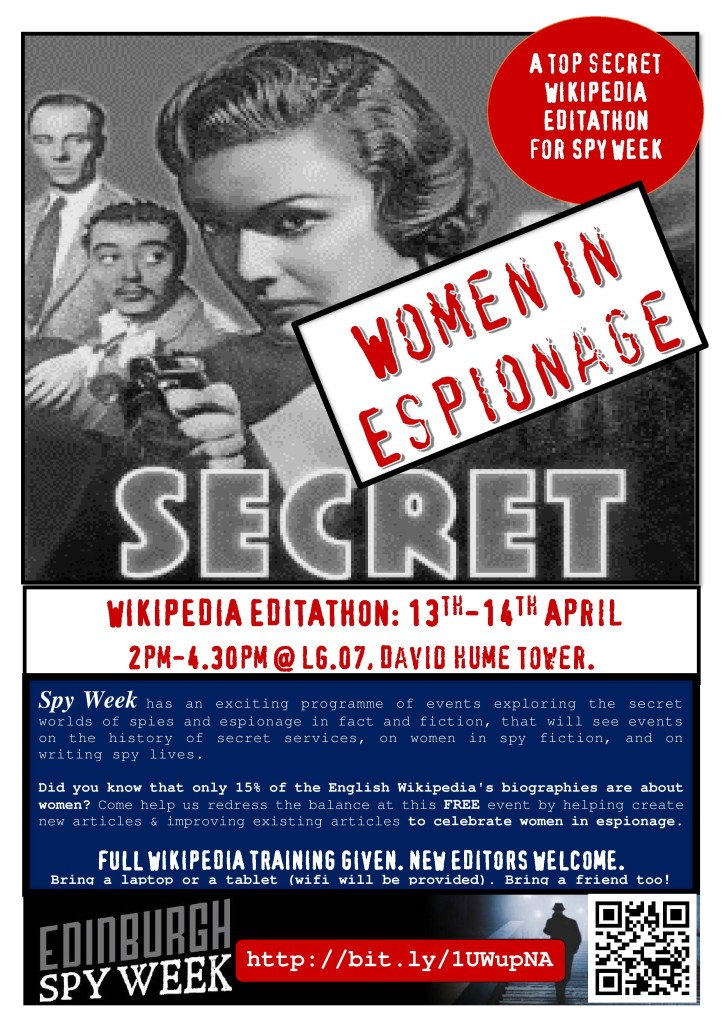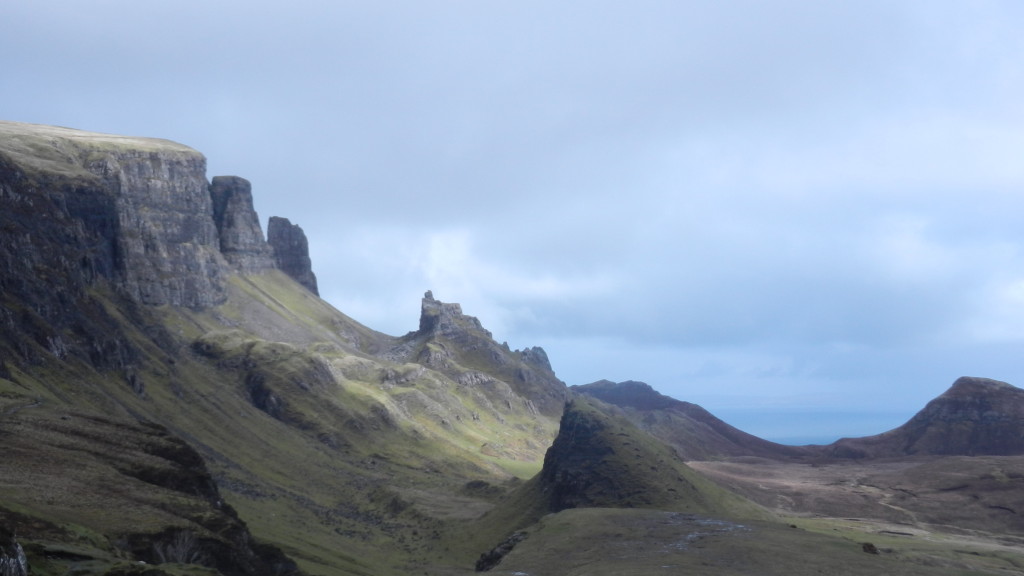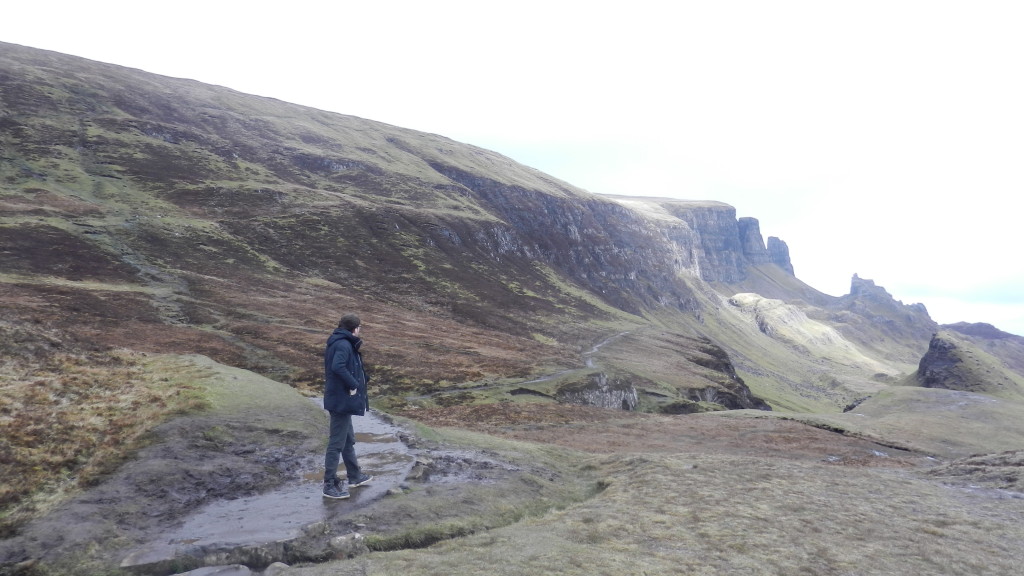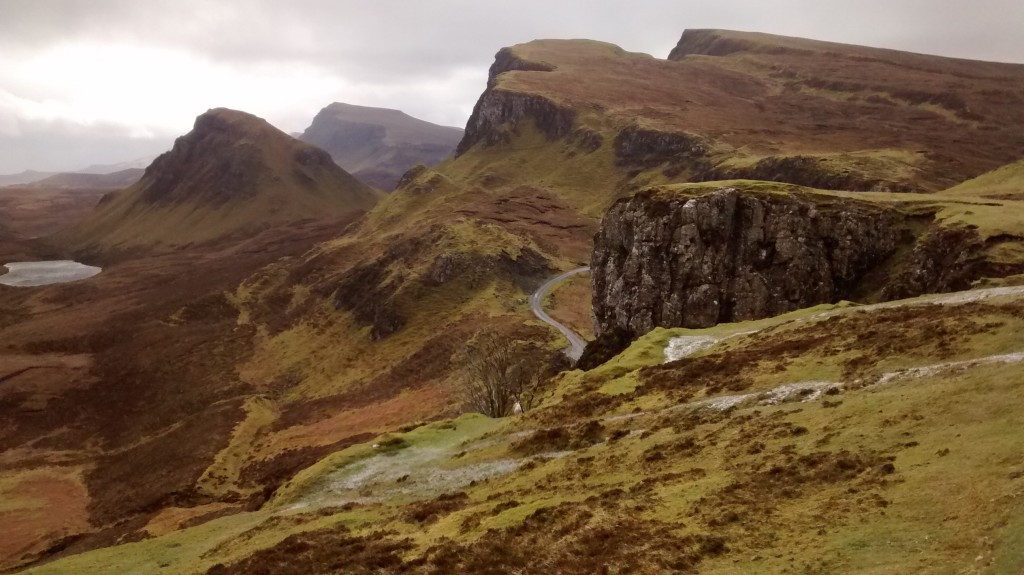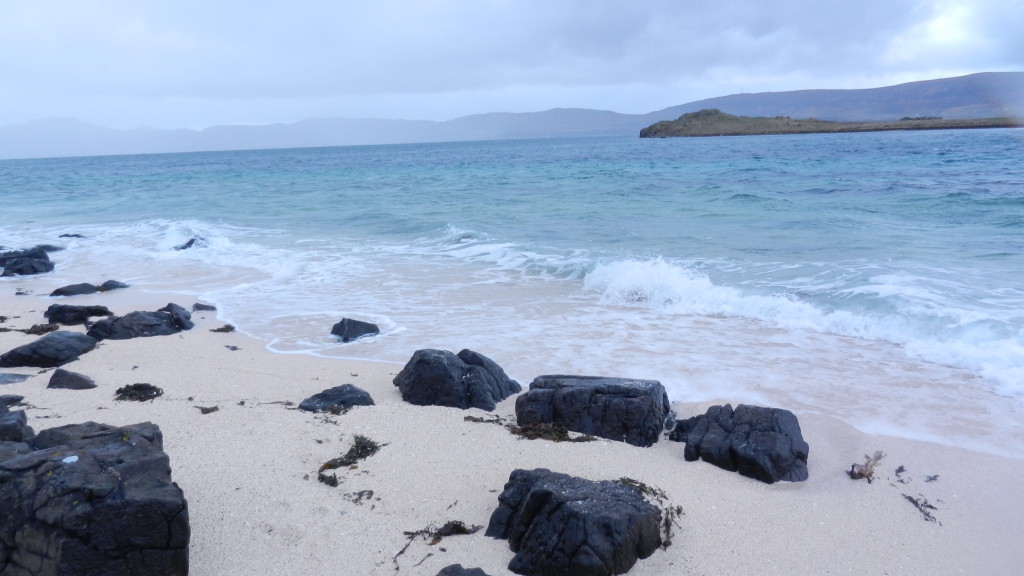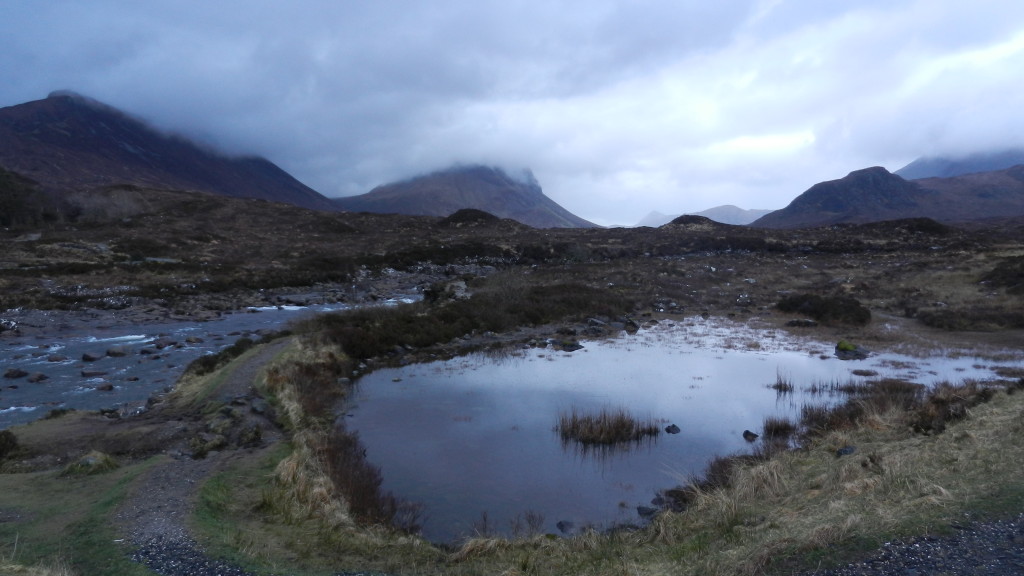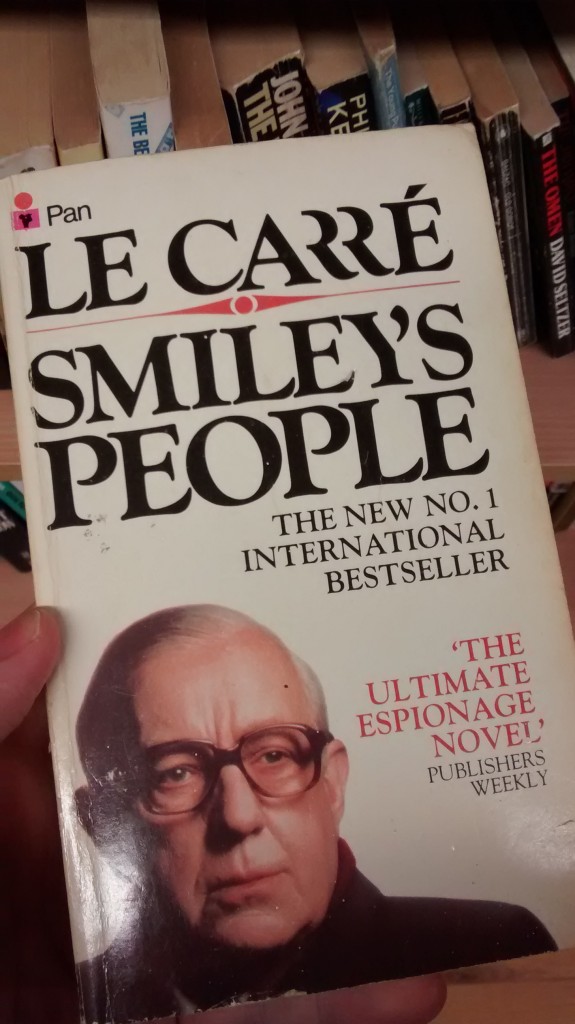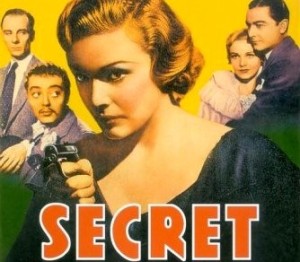Spy Week 2016
Edinburgh Spy Week returned for a third year with an exciting programme of events exploring the secret worlds of spies and espionage in fiction and in fact. If you didn’t attend, here’s what you missed!
Click here to view the story of Spy Week 2016 in pics and tweets.
Programme
Sunday 10 April onwards
Monday 11 April
Tuesday 12 April
Wednesday 13 April
Thursday 14 April
Friday 15 April
Spy Week was organised by the University of Edinburgh, the Institute for Advanced Studies in the Humanities, the National Library of Scotland, and Edinburgh Filmhouse, and Blackwell’s Bookshop.
Women in Espionage
What was new for this year’s Spy Week was that the University of Edinburgh’s Information Services and Wikimedia UK organised a Wikipedia edit-a-thon focused on Women in Espionage on the afternoons of 13-14 April 2016 with Penny Fielding, Grierson Chair of English Literature at the University of Edinburgh, as our guest speaker.
The edit-a-thon then continued as a worldwide virtual event in collaboration with WikiProject Women in Red as, approximately, only 16% of the biographies on Wikipedia relate to notable women and WikiProject Women in Red’s aim is to add to and improve the coverage of individuals, events and resources related to women on Wikipedia. The aim of our edit-a-thon therefore was to do this with a focus on women in espionage.
Outcomes
5 new pages were created and 15 pages were edited by our attendees over the two afternoons on 13th & 14th April which was mightily impressive for two short afternoons’ work. It was great to see our editors uncover the incredible lives of these extraordinary women. It was also terrific to be able to use Wikipedia’s Content Translation tool to translate articles in other languages.
What was truly amazing was the volume of work that Wikiproject Women in Red achieved over the next week running the Women in Espionage edit-a-thon (from 13th April until the 20th of April) alongside their pre-planned events for April on Women Writers and Welsh Women.
An incredible 828 pages edited and 155 new pages created.*
*The figures include all Wikiproject Women in Red events for 13-20th April.
View all the pictures from the Spy Week 2016: Women in Espionage Wikipedia Edit-a-thon
Articles created
Here are the new articles created related to Women in Espionage.
Some truly fascinating stories:
- Eileen Burgoyne – a Cold War Spy who worked for the British Government after the Second World War. Information about Eileen Burgoyne’s life as a spy emerged only after her death when weapons were found by builders at her former home sparked a bomb scare leading to an evacuation of her street. Police later found possessions and documents which revealed her involvement in the intelligence services.
- Jessie Jordan – a Scottish hairdresser who was found guilty of spying for the German Abwehr on the eve of World War II.
- Rozanne Colchester – joined Bletchley Park as a decoder. Post war she held an undisclosed role with the Secret Intelligence Service. Serving in Cairo and Istanbul where she helped investigate the double agent Kim Philby.
- Luisa Zeni – an Italian secret agent and writer.
- Marie Meyer – an American linguist and spy who worked for the National Security Agency from 1943-60. She was assigned to the Venona project and is credited with making some of the first recoveries of the Venona codebook. She studied eight foreign languages and was the first person to receive the NSA’s Meritorious Civilian Service Award.
- Magda Fontanges – also known as Madeleine Coraboeuf, was a French actress, journalist and a spy for the Germany Secret Service between 1940 and 1943. Fontanges was found guilty of shooting Count Charles de Chambrun, the then French Ambassador to Rome, at the Gare du Nord on March 17. Fontanges accused the Comte De Chambrun of compromising her situation by revealing the details of her love affair with Mussolini to the then secretary of the French Embassy in Rome, M. Garnier. She was fined 100 Francs (1 Great British Pound), and given a suspended sentence due to having no previous criminal record.
- Ginette Jullian: a French spy during the Second World War, she trained for the SOE, learning parachuting, security, and wireless operation.
- Sarah Helm – a British journalist and non-fiction writer. She worked for The Sunday Times and The Independent in the 1980s and 1990s. Her first book, A Life in Secrets detailing the life of the secret agent Vera Atkins, was published in 2005.
- Melissa Boyle Mahle – a writer and former Central Intelligence Agency officer in the Middle East. Her books include Denial and Deception: An Insider’s View of the CIA from Iran-Contra to 9/11. She acted as a consultant for the film Salt.
- Minnie M. Kenny – served as a cryptanalyst, educator and equal opportunity activist who worked at the National Security Agency.
- Astrid Dövle Dollis Dahlgren – nicknamed the “Scandinavian ‘Mata Hari'” was a Norwegian dentist and property dealer. After she became Swedish by marriage she worked for Nazi Germany during World War II.
- Juliana Mickwitz – She was employed with the American military and later National Security Agency as a translator, linguist and cryptanalyst. She was inducted into the Cryptologic Hall of Honor in 2012.
- Dorothy Blum – an American computer scientist and cryptanalyst. She wrote computer software for the NSA and spearheaded the effort to teach NSA employees to write cryptanalytic programs. She was using the Fortran programming language three years before its public release in 1957. Blum “significantly changed the way NSA did cryptanalysis”. She was also elected one of the top 100 “most outstanding women in the federal government”.
- Josette Bruce – a French novelist of Polish origin. She is remembered for taking over the literary series OSS 117 about secret agent Hubert Bonisseur de La Bath after the death of her husband Jean Bruce, creator of the series.
- Leslie Silbert – an American writer who has worked as a private investigator. In 2004, she published her first novel The Intelligience, a spy story based on an incident in the life of the British 16th-century author Christopher Marlowe.
- Ruth A. David – an American electrical engineer. While at the CIA, David was responsible for encouraging the agency to pursue partnerships with the private sector and designed a proposal to procure technology at the stage of development from the private sector. She has been awarded the CIA Director’s Award, the Defense Intelligence Agency Director’s Award, the CIA Distinguished Intelligence Medal, the National Reconnaissance Officer’s Award for Distinguished Service, and the National Security Agency Distinguished Service Medal.
- Ruth Mitchell – a reporter who was the only American woman to serve with the Serbian anti-Axis Chetnik guerrillas under Draža Mihailović in World War II. She was captured by the Gestapo and spent a year as a prisoner of war, later writing a book about her experiences. She also wrote a book about one of her brothers, General Billy Mitchell, who is regarded as the founder of the U.S. Air Force.
- Grace Banker – a telephone operator who served during World War I (1917-1918) as Chief Operator of telephones of the American Expeditionary Forces (AEF) in the U.S. Army Signal Corps. She was the leader of 33 women telephone operators known popularly as Hello Girls who were assigned from New York to travel to France and work at the war front in Paris, Chaumont to operate the telephone switch boards at the First Army headquarters. About her work in the war front she said that “the secrecy surrounding their operations gave it an aura of romance and set it apart from the civilian work.”
Articles improved
- Lilian Rolfe – an Allied secret agent in World War II.
- Stella Rimington – a British author and former Director General of MI5, a position she held from 1992 to 1996. She was the first female DG of MI5, and the first DG whose name was publicised on appointment.
- Lise de Baissac – a heroine of the Special Operations Executive during the Second World War, a special agent who risked her life running her own operations; she was awarded several gallantry awards after the war.
- Kim Philby – a high-ranking member of British intelligence who worked as a double agent before defecting to the Soviet Union in 1963. He served as both an NKVD and KGB operative.
- Pearl Witherington – a World War II Special Operations Executive agent. Given the code name “Marie”, Witherington was dropped by parachute into occupied France in September 1943, where she joined Maurice Southgate, leader of the Stationer Network. Over the next eight months, she worked as Southgate’s courier. After the Gestapo arrested Southgate in May 1944 who was subsequently deported to Buchenwald, she became leader of the new Wrestler Network, under a new code-name “Pauline”. Her story has been cited as the inspiration for the Sebastian Faulks novel Charlotte Gray.
- Charles Medhurst – a First World War Royal Flying Corps pilot on the Western Front and later a senior officer in the Royal Air Force (father of Rozanne Colchester).
- Marie Christine Chilver also known by the codename Agent Fifi, was a British secret agent in World War II. Originally recruited after escaping the Nazis and helping a British airman return to England, she worked for the Special Operations Executive assessing and testing the security awareness of trainee secret agents.
- Agent 355 – the code name of a female spy during the American Revolution, part of the Culper Ring. Agent 355 is one of the first spies for the United States, but her real identity is unknown. Agent 355 is thought to have played a major role in exposing Benedict Arnold and the arrest of Major John Andre.
Overall, the outcome of the edit-a-thon was really pleasing given that, potentially, sources could have been hard to find for these secretive but extremely notable women. But the feeling is we have hit a rich vein that could see us continue in future edit-a-thon sessions.
What is MORE pleasing is that, two weeks on, Wikipedia editors are continuing to create new pages using our event page’s hitlist of articles, even as late as yesterday, from all round the world; from locations as near as Northern England and as far away as continental Europe, Asia, Australia and the USA.
Long may it continue.
Roll on Spy Week 2017!



